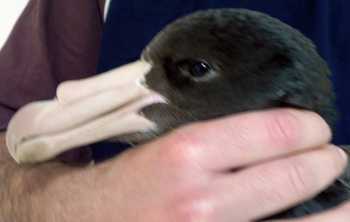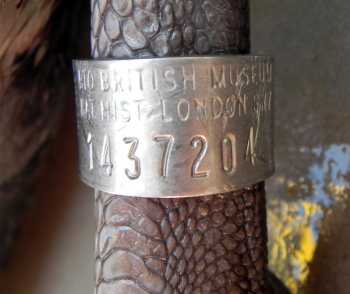Giant petrels Macronectes spp. are usually considered to be birds of high latitudes, breeding on islands in the Southern Ocean and (for the southern species) on the Antarctic Continent. The most northerly breeding locality for the genus currently is Gough Island at 40° 17'S in the South Atlantic where Southern Giant Petrels M. giganteus breed. However, individuals do from time to time wander northwards into balmier climes.
New Caledonia is a group of tropical islands a little north of the Tropic of Capricorn in the Pacific Ocean to the east of Australia. It is a "Special Collectivity" (since 1999; previously an Overseas Territory) of France.
A record has recently come to light of a juvenile Northern Giant Petrel M. halli carrying a leg-mounted geolocator (GLS) and British Trust for Ornithology band number 1437204 that was caught near a Sperm Whale Physeter macrocephalus carcass that was grounded on a barrier reef near Cap Goulvain (165° 23'E; 21° 55'S) on Grande Terre, New Caledonia on 1 July 2010. After being photographed the bird was released on the same day near Pointe Akaïa, close to the town of Bourail without the logger (pictured below) being removed.
The giant petrel was banded as a chick at Bird Island, South Georgia (Islas Georgias del Sur)* in the South Atlantic from where it fledged on 31 March 2010.




Photographs courtesy of the Nature Rangers Brigade, DENV, Province Sud, New Caledonia
Both species of giant petrels, mainly juveniles, have been occasionally recorded in New Caledonia as well as in nearby Fiji and Vanuatu in the tropical Pacific (see reference list below).
Other ACAP-listed species recorded as vagrants within New Caledonian waters include Wandering Albatross Diomedea exulans, Buller's Albatross Thalassarche bulleri and Light-mantled Sooty Albatross Phoebetria palpebrata (Barré et al. 2009).
Selected references:
Barré, N. & Dutson, G. 2000. Liste commentée des oiseaux de Nouvelle-Calédonie. Supplément à la revue. Alauda 68: Supplement 3.
Barré, N., Baudat-Franceschi, J., Spaggiari, J., Chartendrault, V., Bachy, P., Desmoulins, F. & Guhring, J. 2007. Second complément à la liste des oiseaux de Nouvelle-Calédonie. Alauda 75: 129-144.
Barré, N., Hébert, O., Aublin, R., Spaggiari, J., Chartendrault, V., Baillon, N. & Le Bouteiller, A. 2009. Troisième complément à la liste des oiseaux de Nouvelle-Calédonie. Alauda 77: 287-302.
Bregulla, H.L. 1992 Birds of Vanuatu. Oswestry: Anthony Nelson.
Clunie, F. 1980. Two more giant petrel records from Fiji. Notornis 27: 95.
Hannecart, F. & Létocart, Y. 1983. Oiseaux de Nouvelle-Calédonie et des Loyautés. Nouméa: Editions Cardinalis.
Patterson, D.L. & Hunter, S. 2000. Giant petrel Macronectes spp. band recovery analysis from the International Giant Petrel Banding Project, 1988/89. Marine Ornithology 28: 69-74.
Jenkins, J. 1980. Giant petrel in Fijian waters. Notornis 27: 95.
Jenkins, J., Cheshire, N. & Nesfield, P. 1977. Some data on the distribution of giant petrels in the Tasman Sea and the South West Pacific. Australasian Seabird Bulletin 8: 12-19.
King, W. 1967. Seabirds of the Tropical Pacific Ocean. Washington, D.C.: Smithsonian Institution.
Morgan, B. & Morgan, J. 1965. Some notes on the birds of the Fiji Islands. Notornis 12: 158-168.
With thanks to Julien Baudat-Franceschi, Seabirds Officer, Société Calédonienne d'Ornithologie and the Nature Rangers Brigade, Direction de l'Environnement (DENV), Province Sud, New Caledonia, and to Richard Phillips and Andy Wood, British Antarctic Survey for information and for photographs.
John Cooper, ACAP Information Officer, 1 July 2012
*A dispute exists between the Governments of Argentina and the United Kingdom of Great Britain and Northern Ireland concerning sovereignty over the Falkland Islands (Islas Malvinas), South Georgia and the South Sandwich Islands (Islas Georgias del Sur y Islas Sandwich del Sur) and the surrounding maritime areas.

 English
English  Français
Français  Español
Español